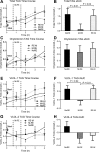Postdinner resistance exercise improves postprandial risk factors more effectively than predinner resistance exercise in patients with type 2 diabetes
- PMID: 25539939
- PMCID: PMC4346741
- DOI: 10.1152/japplphysiol.00917.2014
Postdinner resistance exercise improves postprandial risk factors more effectively than predinner resistance exercise in patients with type 2 diabetes
Abstract
Abnormally elevated postprandial glucose and triacylglycerol (TAG) concentrations are risk factors for cardiovascular disease in type 2 diabetes. The most effective time to exercise to lower postprandial glucose and TAG concentrations is unknown. Thus the aim of this study was to determine what time is more effective, either pre- or postdinner resistance exercise (RE), at improving postprandial risk factors in patients with type 2 diabetes. Thirteen obese patients with type 2 diabetes completed three trials in a random order in which they consumed a dinner meal with 1) no RE (NoRE), 2) predinner RE (RE → M), and 3) postdinner RE beginning 45 min after dinner (M → RE). Clinical outcome measures included postprandial glucose and TAG concentrations. In addition, postprandial acetaminophen (gastric emptying), endocrine responses, free fatty acids, and β-cell function (mathematical modeling) were measured to determine whether these factors were related to changes in glucose and TAG. The TAG incremental area under the curve (iAUC) was ∼92% lower (P ≤ 0.02) during M → RE compared with NoRE and RE → M, an effect due in part to lower very-low-density lipoprotein-1 TAG concentrations. The glucose iAUC was reduced (P = 0.02) by ∼18 and 30% during the RE → M and M → RE trials, respectively, compared with NoRE, with no difference between RE trials. RE → M and M → RE reduced the insulin iAUC by 35 and 48%, respectively, compared with NoRE (P < 0.01). The glucagon-like peptide-1 iAUC was ∼50% lower (P ≤ 0.02) during M → RE compared with NoRE and RE → M. Given that predinner RE only improves postprandial glucose concentrations, whereas postdinner RE improves both postprandial glucose and TAG concentrations, postdinner RE may lower the risk of cardiovascular disease more effectively.
Keywords: exercise timing; glucose metabolism; glycemic control; lipid metabolism; obesity; weight training.
Copyright © 2015 the American Physiological Society.
Figures






Comment in
-
Exercising tactically for metabolic control.J Appl Physiol (1985). 2015 Apr 15;118(8):1088. doi: 10.1152/japplphysiol.00050.2015. J Appl Physiol (1985). 2015. PMID: 25878222 No abstract available.
-
Reply to Dr. Chacko.J Appl Physiol (1985). 2015 Apr 15;118(8):1089. doi: 10.1152/japplphysiol.00081.2015. J Appl Physiol (1985). 2015. PMID: 25878223 Free PMC article. No abstract available.
-
Clarifications.J Appl Physiol (1985). 2015 Jul 15;119(2):159. doi: 10.1152/japplphysiol.00351.2015. J Appl Physiol (1985). 2015. PMID: 26177973 No abstract available.
-
Reply to Dr. Chacko.J Appl Physiol (1985). 2015 Jul 15;119(2):160. doi: 10.1152/japplphysiol.00372.2015. J Appl Physiol (1985). 2015. PMID: 26177974 No abstract available.
References
-
- Abbasi F, Chu JW, McLaughlin T, Lamendola C, Leary ET, Reaven GM. Effect of metformin treatment on multiple cardiovascular disease risk factors in patients with type 2 diabetes mellitus. Metabolism 53: 159–164, 2004. - PubMed
-
- Colberg SR, Zarrabi L, Bennington L, Nakave A, Thomas Somma C, Swain DP, Sechrist SR. Postprandial walking is better for lowering the glycemic effect of dinner than pre-dinner exercise in type 2 diabetic individuals. J Am Med Dir Assoc 10: 394–397, 2009. - PubMed
-
- Dalgaard M, Thomsen C, Hermansen K. Effects of one single bout of low-intensity exercise on postprandial lipaemia in type 2 diabetic men. Br J Nutr 92: 469–476, 2004. - PubMed
Publication types
MeSH terms
Substances
Grants and funding
LinkOut - more resources
Full Text Sources
Other Literature Sources
Medical

